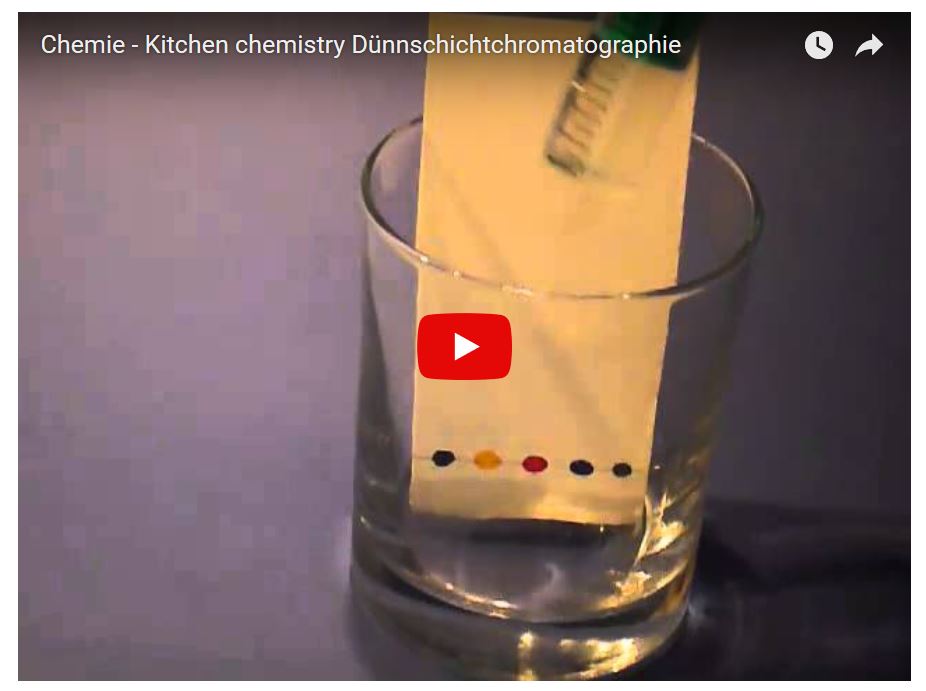In der dritten Woche des MOOC’s „Kitchen chemistry“ beschäftigen wir uns unter anderem mit der Chromatographie als Trennverfahren. Ich möchte in diesem Beitrag drei verschiedene Trennverfahren vorstellen.
In this part, we work with the chromatography as a separation. In this post, I want to introduce three different separation processes.
Papierchromatographie: Ich habe einen Rundfilter benutzt. In der Mitte habe ich ein kleines Loch geschnitten. An den Rändern von diesem Loch trage ich jeweils eine Filzstiftfarbe auf. Ein Streifen von dem Rundfilterpapier wird gerollt und in das Loch gesteckt. Ich fülle eine Glasschale mit Wasser und stelle den Streifen in das Wasser. Das Wasser wird von dem Streifen hochgezogen und verteilt sich auf dem Rundfilter. Nach 5 Minuten ist das Chromatogramm fertig. Betrachten Sie das Video.
Paper chromatography: I used a round filter. I cut a small hole in the middle. On the edges of this hole, I put a felt-tip pen colour. A strip of the circular filter paper is rolled and inserted into the hole. I filled a glass bowl with water and place the strip in the water. The water is pulled up from the S strip and spread on the round filter. After 5 minutes, the chromatogram is finished. Have a look at the video.
Dünnschichtchromatographie: Ich habe eine fertige DC Platte benutzt. Ca. 1 cm vom unteren Rand habe ich mit einem Bleistift vorsichtig eine Linie gezogen. Diese ist meine Startlinie. Auf der Startlinie werden die einzelnen Punkte der Filzstiftfarben aufgetragen. In einen Becher habe ich Wasser gefüllt (ca. 0,5 cm hoch) und die Platte hinein gestellt. Nach ca. 5 Minuten habe ich die Platte aus dem Wasser entfernt und die Fließmittelfront mit Bleistift markiert. Betrachten Sie das Video.
Thin-layer chromatography: I used a prepared DC plate. I carefully drew a line with a pencil about 1 cm from the bottom of it. This is my starting line. I applied the individual spots of the felt-tip pen colours to the starting line. I put water (approx. 0.5 cm high) into a cup and put the plate inside. After about 5 minutes I removed the plate from the water and marked the front of the flow medium with a pencil. Have a look at the video.
Chromatographie mit Kreide
Ich habe ein Stück Kreide benutzt. Ca. 1 cm vom unteren Rand werden die einzelnen Punkte der Filzstiftfarben aufgetragen. In einen Becher habe ich Wasser gefüllt (ca. 0,5 cm hoch) und die Kreide hinein gestellt. Nach ca. 5 Minuten habe ich die Kreide aus dem Wasser entfernt. Betrachten Sie das Video.
Chromatography with chalk
I used a piece of chalk. The individual spots of the felt-tip pen colours were applied approx 1 cm from the lower edge. I put water (approx. 0.5 cm high) and the chalk into a cup. After about 5 minutes I removed the chalk from the water. Have a look at the video.





